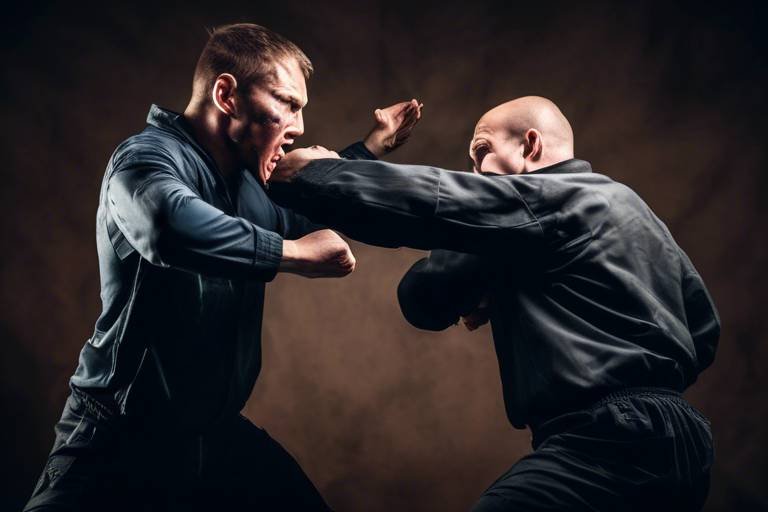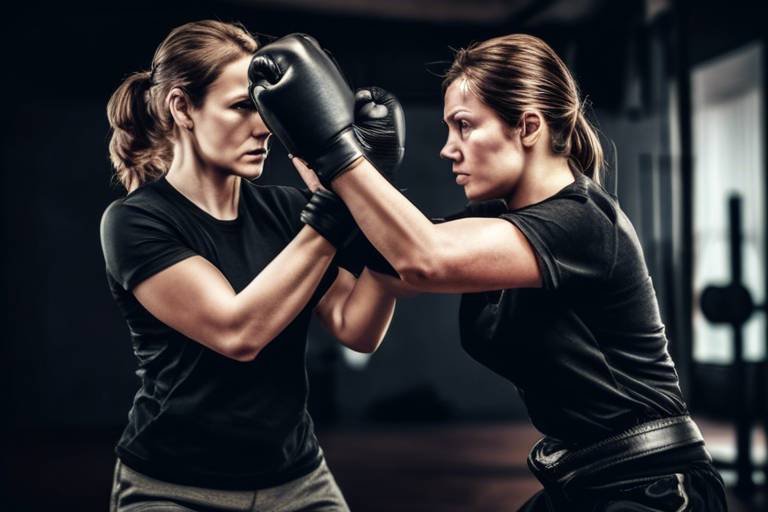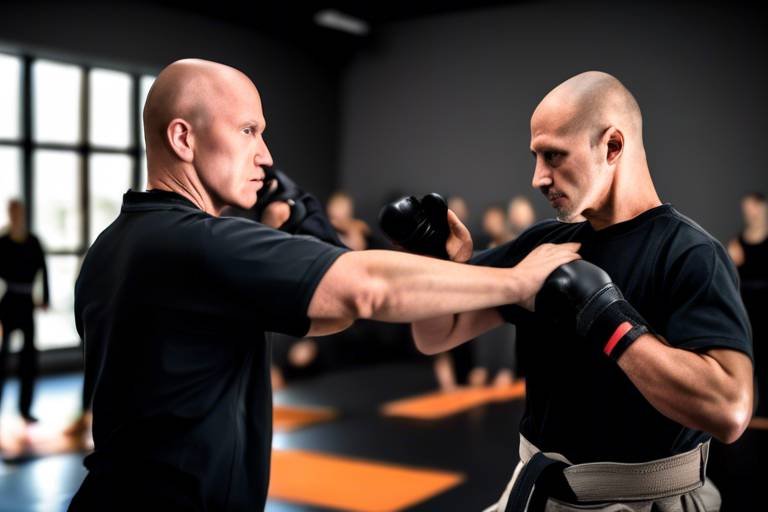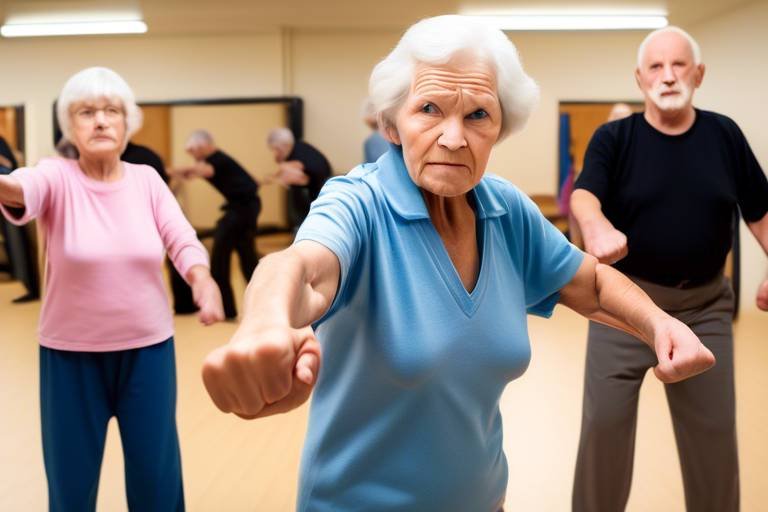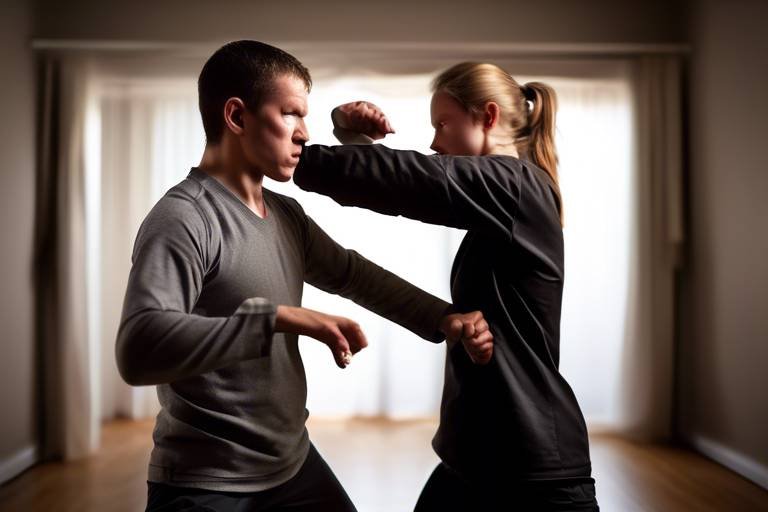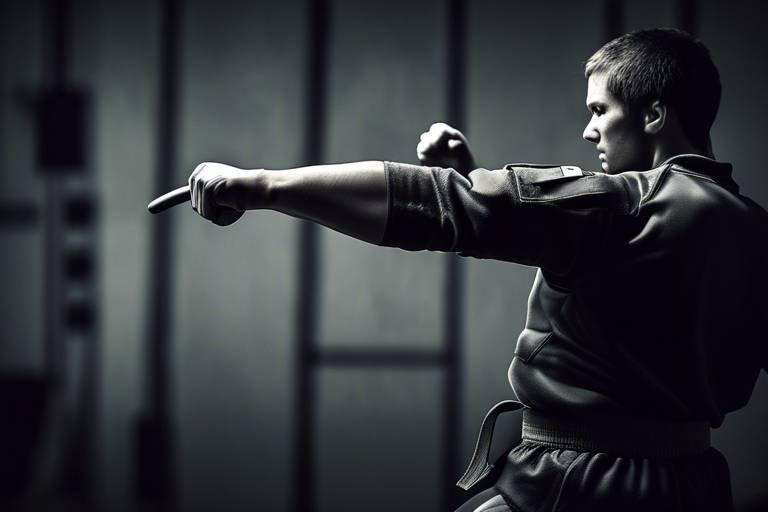How to Mix Boxing with Your Self-Defense Techniques?
In a world where personal safety is paramount, understanding how to protect oneself is more important than ever. Combining the art of boxing with self-defense techniques can be a game-changer, offering not just physical skills but also a boost in confidence and awareness. Imagine being able to throw a punch with precision while simultaneously knowing how to evade an attack—this is the essence of mixing boxing with self-defense. In this article, we’ll dive into the practical tips and strategies that can elevate your self-defense skills, making you not just a fighter, but a smart one.
Before you can effectively integrate boxing into your self-defense arsenal, it's crucial to understand the fundamental principles of boxing. Think of boxing as the backbone of your self-defense strategy. It’s not just about throwing punches; it’s about stance, footwork, and timing. Your stance provides the stability you need to deliver powerful strikes while being ready to move. Footwork is your ticket to maintaining distance and creating angles against an opponent. And the punches? Well, they’re your primary tools for offense. Mastering these basics is essential for building a strong foundation for your self-defense practice.
Now, you might be wondering, "What’s in it for me?" Integrating boxing into your self-defense training comes with a plethora of benefits. For starters, it significantly improves your reflexes and reaction time, which are vital in high-pressure situations. The more you practice, the quicker your body learns to respond to threats. Additionally, boxing enhances your stamina and striking power. Think of it like this: just as a well-oiled machine runs smoothly, your body becomes a finely tuned instrument ready to defend itself when needed. The transformation you undergo not only prepares you for real-world confrontations but also instills a sense of confidence that radiates beyond the training mat.
When it comes to self-defense, your ability to react quickly can mean the difference between safety and danger. Boxing drills are designed to hone these quick movements. For instance, engaging in exercises like the slip drill or the double-end bag can sharpen your reflexes. These drills mimic the unpredictability of real-life confrontations, making you more prepared for the unexpected. Imagine being caught off guard; with these skills, your body instinctively knows how to respond. It’s like having a built-in alarm system that springs into action at the slightest hint of trouble.
Shadow boxing is one of the most effective methods for practicing your footwork and punches without needing a partner. It allows you to visualize an opponent while working on your technique. You can practice your jabs, hooks, and footwork in front of a mirror, refining your movements and ensuring you're ready to execute them in a real situation. Incorporating shadow boxing into your routine not only improves your skills but also builds your confidence. Picture yourself in a fight, moving fluidly and striking accurately—this mental rehearsal is invaluable.
While shadow boxing is fantastic, working with a partner can take your training to the next level. Partner drills simulate real-life scenarios, enhancing your ability to respond quickly and effectively. For example, practice reacting to a partner's feints or sudden movements. This not only improves your reaction time but also helps you learn how to read your opponent’s intentions. Think of it as a dance—each partner must be in sync, anticipating the other's moves, which ultimately prepares you for the unpredictability of a real encounter.
Powerful strikes can deter attackers and give you the upper hand in self-defense situations. To develop striking strength, focus on techniques like the heavy bag workouts and plyometric exercises. These methods not only build muscle but also enhance your speed and accuracy. Remember, it’s not just about brute strength; it’s about technique and timing. When you combine these elements, your punches become more than just physical—they become a statement. A well-placed punch can change the dynamics of a confrontation, making it clear that you are not an easy target.
Learning to blend boxing techniques with self-defense moves is crucial for maximizing effectiveness. It’s like mixing the right ingredients in a recipe; the right combinations can create a powerful dish. For instance, utilizing effective punch combinations can create openings in an attacker’s defense. Knowing when to strike and when to evade is key. It’s not just about throwing punches; it’s about reading the situation and responding appropriately. Integrating defensive movements such as head movement and blocking into your repertoire will ensure you’re not just an offensive fighter but a well-rounded self-defender.
Understanding how to execute punch combinations can create openings in an attacker's defense. For example, a simple jab followed by a cross can be effective in creating space. Learning these combinations can be likened to playing chess; you need to think several moves ahead to outsmart your opponent. Practicing these combinations will not only improve your striking but also your ability to think strategically in a confrontation.
Defensive movements are just as important as offensive techniques. Incorporating head movement, blocking, and footwork from boxing into your self-defense repertoire is essential. Think of your defense as a shield; it protects you while allowing you to counterattack effectively. When you can evade an attack while preparing to strike back, you create a powerful advantage. Remember, in self-defense, it’s not just about the fight; it’s about surviving and escaping safely.
- Can anyone learn boxing for self-defense? Absolutely! Boxing can be tailored to fit any skill level, making it accessible for everyone.
- How long does it take to see improvement? With consistent practice, many people notice improvements in just a few weeks.
- Is boxing training safe? Yes, when practiced with proper techniques and under supervision, boxing training is generally safe.

Understanding Boxing Fundamentals
To effectively integrate boxing into your self-defense techniques, it's crucial to start with a solid understanding of boxing fundamentals. Think of boxing as the backbone of your self-defense strategy; without it, your skills may lack the strength and finesse needed to handle real-world confrontations. So, what are the key elements that make up this robust foundation? Let's break it down.
First and foremost, the stance is your starting point. A proper boxing stance not only provides balance but also allows for quick movement in any direction. Imagine yourself as a coiled spring, ready to unleash your energy at a moment's notice. Your feet should be shoulder-width apart, with your dominant foot slightly back. Keep your knees slightly bent and your weight evenly distributed. This position enables you to pivot, dodge, and launch powerful strikes when necessary.
Next up is footwork. In boxing, footwork is like the rhythm in a dance; it keeps you moving fluidly while maintaining your balance. Good footwork allows you to create distance, evade attacks, and position yourself for counterattacks. Spend time practicing basic footwork drills, such as the jab step, lateral movement, and pivoting. These movements will not only improve your boxing skills but also enhance your overall agility in self-defense situations.
Now let’s talk about punches. Boxing is all about striking, and knowing how to throw effective punches can make a world of difference in a self-defense scenario. The main types of punches you'll want to master include:
- Jab: A quick, straight punch that helps gauge distance and set up more powerful strikes.
- Cross: A powerful punch thrown with your dominant hand, aimed at your opponent's head or body.
- Hook: A punch that comes from the side, targeting the opponent's jaw or ribs.
- Uppercut: An upward punch that can be devastating when executed correctly, especially at close range.
Each of these punches has its own unique role in both boxing and self-defense. By mastering these techniques, you can create a versatile striking arsenal that will serve you well in high-pressure situations.
Lastly, let's not forget about the importance of defensive techniques. In boxing, learning how to avoid or block punches is just as vital as knowing how to throw them. Techniques such as slipping, bobbing, and weaving can help you evade attacks while positioning yourself for a counter. These defensive maneuvers can be the difference between getting hit and staying safe in a confrontation.
In conclusion, understanding boxing fundamentals is essential for anyone looking to enhance their self-defense skills. By focusing on stance, footwork, punches, and defensive techniques, you’ll build a solid foundation that will not only bolster your confidence but also make you more effective in real-world situations. Remember, practice makes perfect, so get out there and start honing these skills!

Benefits of Incorporating Boxing
Integrating boxing into your self-defense training is not just about throwing punches; it’s about transforming your entire approach to personal safety. When you think of boxing, you might picture a ring, gloves, and a referee, but the reality is that the principles of boxing can significantly enhance your self-defense capabilities. First off, let’s talk about reflexes. Boxing is renowned for its ability to sharpen your reaction time. In a self-defense situation, that split-second decision can mean the difference between safety and danger. Imagine being able to dodge an incoming punch or sidestep an attacker at the last moment. This is where boxing shines.
Moreover, boxing training is a fantastic way to boost your stamina. The rigorous conditioning involved in boxing workouts builds endurance, allowing you to maintain energy during a confrontation. Think of it like running a marathon; if you’re not conditioned, you’ll tire out long before the finish line. With enhanced stamina, you can keep your wits about you, making it easier to think clearly and act decisively when it matters most.
Another crucial benefit is the striking power you develop. Boxing teaches you how to generate force effectively, allowing you to deliver powerful punches that can deter an attacker. When you land a solid hit, it can create an opportunity for you to escape or gain control of the situation. This is particularly vital in self-defense scenarios where you might need to neutralize a threat quickly. The combination of technique and strength you gain from boxing translates to real-world effectiveness.
Let’s not forget the psychological boost that comes from knowing how to defend yourself. The confidence gained from boxing training can be a game-changer. It’s one thing to know a few self-defense moves, but it’s another to have the skills and conditioning to back it up. When you feel empowered, you’re less likely to be seen as a target. In high-pressure situations, confidence can be your greatest ally.
Here’s a quick overview of how boxing enhances your self-defense:
| Benefit | How It Helps in Self-Defense |
|---|---|
| Improved Reflexes | Allows for quicker reactions to threats. |
| Increased Stamina | Helps maintain energy during confrontations. |
| Enhanced Striking Power | Deters attackers with effective punches. |
| Boosted Confidence | Reduces the likelihood of being targeted. |
In conclusion, the benefits of incorporating boxing into your self-defense training are multifaceted. From improved reflexes and stamina to enhanced striking power and confidence, boxing equips you with the tools needed to handle various situations effectively. So, if you’re looking to elevate your self-defense skills, consider stepping into the boxing ring. It’s not just about fighting; it’s about empowering yourself to face challenges head-on.

Improving Reflexes and Reaction Time
When it comes to self-defense, having quick reflexes and sharp reaction times can be the difference between safety and danger. Imagine being in a situation where you need to react instantly to an attack; your ability to move swiftly and effectively can save you. Boxing drills are specifically designed to enhance these vital skills, making them an excellent addition to your self-defense training. By incorporating boxing techniques, you can train your body to respond to threats in real-time, almost like a well-oiled machine.
One of the most effective ways to improve your reflexes is through consistent practice of various boxing drills. These drills focus on quick movements and reactions, helping you to develop muscle memory that triggers an automatic response when faced with danger. For instance, practicing slips and weaves not only makes you harder to hit but also trains your body to react instinctively to incoming strikes. When you combine these movements with footwork, you're not just dodging punches; you're also setting yourself up for counterattacks.
Incorporating shadow boxing into your routine can be a game-changer. This technique allows you to practice your footwork and punches without needing a partner. As you move around, visualize an opponent in front of you, and focus on your speed and precision. Shadow boxing helps you to sharpen your skills while enhancing your coordination and agility. You can even use a mirror to observe your movements, allowing you to make adjustments and improve your technique.
Another effective method for boosting your reflexes is through partner drills. Working with a training partner can simulate real-life scenarios where you must react quickly. For example, you can practice reaction drills where one partner throws punches while the other practices defensive movements. This not only sharpens your reflexes but also helps you to anticipate your partner's actions, making you more prepared for unpredictable situations. The dynamic nature of these drills can replicate the stress of a real confrontation, providing a valuable training experience.
To further enhance your training, consider incorporating the following exercises into your regimen:
- Focus Mitt Drills: These drills improve hand-eye coordination and reaction time. Your partner holds pads, and you react to their movements with quick punches.
- Speed Bag Training: This classic boxing tool helps develop rhythm and timing, essential for quick reactions.
- Agility Ladder Exercises: These drills improve foot speed and coordination, allowing you to move quickly in any direction.
In essence, improving your reflexes and reaction time is like sharpening your instincts. The more you train, the more automatic your responses become. Think of it as programming your body to react in a split second, just like a computer executing a command. With consistent practice of boxing techniques, you will not only become a more effective self-defender but also gain the confidence to handle potentially dangerous situations.
Q: How often should I practice boxing drills to improve my reflexes?
A: Ideally, you should practice boxing drills at least 3-4 times a week to see significant improvements in your reflexes.
Q: Can I practice shadow boxing without a coach?
A: Absolutely! Shadow boxing is a solo activity that you can practice anywhere. Just focus on your movements and technique.
Q: What is the best way to find a training partner?
A: Look for local boxing gyms or self-defense classes where you can meet like-minded individuals. You can also ask friends or family members who are interested in training.

Shadow Boxing Techniques
Shadow boxing is not just a warm-up; it’s a powerful training tool that can elevate your self-defense skills to new heights. Imagine standing in front of a mirror, your fists up, and your mind focused. Each punch you throw and each movement you make is a step toward mastering your body and mind in a self-defense scenario. Shadow boxing allows you to practice your footwork, strikes, and defensive maneuvers without the need for a partner or equipment. It’s like rehearsing for a play—every move counts, and every detail matters.
To get the most out of your shadow boxing sessions, consider these essential techniques:
- Footwork Drills: Start by moving around your space as if you’re in a ring. Practice advancing, retreating, and lateral movements. Good footwork is crucial for both offense and defense, allowing you to create angles and escape potential threats.
- Incorporating Punches: As you move, throw a variety of punches—jabs, crosses, hooks, and uppercuts. Focus on your form and technique. Visualize an opponent in front of you to make the practice more realistic.
- Defensive Maneuvers: Don’t just focus on attacking; practice slipping, ducking, and blocking imaginary punches. This will help you develop the reflexes needed to evade real-life attacks.
One effective way to structure your shadow boxing routine is by following a timed format. For instance, you might set a timer for three minutes of active shadow boxing followed by a one-minute rest. During those three minutes, focus on different aspects of your technique:
| Time (Minutes) | Focus Area |
|---|---|
| 0-1 | Footwork and Movement |
| 1-2 | Punch Combinations |
| 2-3 | Defensive Techniques |
Remember, the key to effective shadow boxing is visualization. Picture a scenario where you might need to defend yourself. Envision an attacker’s movements and practice how you would respond. This mental rehearsal not only enhances your physical skills but also builds confidence, making you feel more prepared for real-life confrontations.
As you get comfortable with the basics, challenge yourself by increasing the intensity. Add in feints, change your rhythm, and incorporate head movement. The more dynamic your shadow boxing becomes, the better prepared you’ll be to handle unexpected situations. It’s like training for a marathon; the more you push your limits, the stronger you become.
Incorporating shadow boxing into your self-defense training routine is a game-changer. It’s not just about throwing punches; it’s about understanding your body and how it moves in space. So, next time you step up to practice, remember to embrace the art of shadow boxing—it could be the difference between being a victim and a survivor.
Q: How often should I practice shadow boxing?
A: Ideally, you should incorporate shadow boxing into your routine at least 2-3 times a week. Consistency is key to improving your skills.
Q: Do I need any equipment for shadow boxing?
A: No equipment is necessary for shadow boxing, making it a convenient option for training anywhere, anytime.
Q: Can shadow boxing help with fitness?
A: Absolutely! Shadow boxing is an excellent cardiovascular workout that can improve your overall fitness while honing your self-defense skills.

Partner Drills for Reaction Time
When it comes to self-defense, the ability to react quickly can mean the difference between safety and danger. Partner drills are an excellent way to hone your reaction time, as they mimic real-life scenarios where you need to respond swiftly. These drills not only enhance your reflexes but also build a sense of timing and distance, which is crucial in any confrontation. Imagine being in a situation where you need to dodge an incoming strike; without the right training, your instincts might fail you. Partner drills help bridge that gap.
One effective exercise involves the use of a focus mitt. In this drill, one partner wears the mitt while the other practices combinations of punches. The mitt holder can randomly call out the target areas, forcing the striker to react instantly. This unpredictability is key, as it simulates the chaotic nature of a real fight. The focus mitt drill not only improves striking accuracy but also allows the striker to develop a keen sense of timing.
Another engaging drill is the reaction ball drill. This involves a small, bouncy ball that unpredictably changes direction when it hits the ground. One partner drops the ball while the other tries to catch it before it bounces twice. This drill enhances hand-eye coordination and reaction time, making it a fun yet challenging exercise. You might feel like a kid again, but the skills you develop here are anything but child’s play!
For a more intense workout, consider incorporating sparring sessions into your training. Sparring not only tests your skills against a live opponent but also forces you to think on your feet. You’ll learn to read your partner’s movements, anticipate strikes, and react accordingly. This dynamic environment is where your training truly comes to life, allowing you to apply boxing techniques in a self-defense context.
Here’s a quick overview of some effective partner drills you can incorporate into your training routine:
| Drill Name | Description | Benefits |
|---|---|---|
| Focus Mitt Drill | One partner holds mitts, while the other strikes based on commands. | Improves striking accuracy and reaction time. |
| Reaction Ball Drill | One partner drops a bouncy ball, and the other tries to catch it. | Enhances hand-eye coordination and quick reflexes. |
| Sparring Sessions | Controlled fighting practice with a partner. | Builds real-time reaction skills and defensive tactics. |
In conclusion, incorporating partner drills into your self-defense training is essential for developing sharp reaction times. Whether you’re working with focus mitts, reaction balls, or engaging in sparring, each drill provides unique benefits that contribute to your overall skill set. Remember, the goal is to create a training environment that simulates real-life scenarios, allowing you to respond instinctively when it matters most. So grab a partner and start drilling—your future self will thank you!
Q: How often should I practice partner drills?
A: Aim for at least two to three times a week to see significant improvement in your reaction time.
Q: Can I do these drills alone?
A: While partner drills are most effective with a partner, some aspects, like shadow boxing, can be practiced solo to improve technique and footwork.
Q: What should I focus on during drills?
A: Concentrate on your timing, distance, and the ability to read your partner’s movements. The more you practice, the more instinctive your reactions will become.

Developing Striking Power
When it comes to self-defense, having striking power can be a game-changer. Imagine being able to deliver a punch that not only stuns your attacker but also gives you the chance to escape unharmed. Developing this kind of power isn't just about brute strength; it's about technique, timing, and understanding how to harness your body's mechanics effectively. So, how do you cultivate this striking power? Let's dive into some essential techniques and training methods that can elevate your punches from mere taps to powerful blows.
First off, it's crucial to understand that striking power comes from a combination of core strength, leg drive, and proper technique. Your legs provide the foundation for your strikes, while your core acts as the engine that drives your punches. When you throw a punch, you're not just using your arms; you're engaging your entire body. Think of it like a whip: the force starts at the base and travels through to the tip. Therefore, focusing on exercises that build core and leg strength is essential. Here are some exercises that can help:
- Squats: These build leg strength, which is vital for generating power.
- Planks: A strong core is necessary for stability and power transfer.
- Medicine Ball Throws: These mimic the explosive movement of a punch.
In addition to strength training, practicing your punching technique is vital. This means not just throwing punches but doing so with precision and control. Shadow boxing allows you to focus on form without the distraction of a partner. Start by practicing your jab, cross, and hooks, paying attention to your stance and how your body moves with each punch. Remember, a well-executed punch can be more effective than a wild swing. To help you visualize this, consider the following table that outlines the key aspects of effective punching technique:
| Technique | Description | Tips |
|---|---|---|
| Jab | A quick, straight punch used to gauge distance and set up combinations. | Keep your elbow in and snap your hand back quickly. |
| Cross | A powerful straight punch thrown with the rear hand. | Rotate your hips and shoulders for maximum power. |
| Hook | A punch thrown in a circular motion aimed at the side of the opponent's head. | Use your legs to pivot and generate torque. |
Moreover, sparring with a partner can significantly enhance your striking power. It allows you to practice your punches in a more dynamic environment, where you can learn to adjust your techniques in real-time. When sparring, focus on the following:
- Using your legs to push off the ground for added power.
- Maintaining a balanced stance to avoid overreaching.
- Practicing combinations to develop fluidity in your striking.
Finally, don’t underestimate the importance of mental preparation. Visualization techniques can help you mentally rehearse your strikes, making your body more prepared to execute them in a high-pressure situation. Picture yourself delivering a powerful punch, feeling the energy flow through your body, and the impact it will have. This mental practice can be just as important as physical training.
In summary, developing striking power is a multifaceted process that requires dedication, practice, and a focus on technique. By integrating strength training, technique drills, and sparring into your routine, you'll not only enhance your punching power but also boost your confidence in self-defense situations. Remember, the goal is to be prepared, so when the moment arises, you can deliver a strike that makes a difference.
Q: How often should I practice my striking techniques?
A: Consistency is key! Aim for at least 2-3 times a week, incorporating both solo drills and partner work.
Q: Can I develop striking power without a gym?
A: Absolutely! You can perform bodyweight exercises and shadow boxing at home. Just focus on your technique and form.
Q: What should I do if I feel my punches aren't powerful enough?
A: Reassess your technique and consider working on your core and leg strength. Sometimes, small adjustments can lead to significant improvements.

Combining Techniques for Self-Defense
When it comes to self-defense, it's not just about knowing how to throw a punch or deliver a kick. Instead, the real magic happens when you combine various techniques into a seamless flow of movement. Imagine being in a high-pressure situation where every second counts. The ability to blend your boxing skills with self-defense maneuvers can be the difference between escaping safely and being caught off guard. This section explores how to effectively combine these techniques to maximize your self-defense capabilities.
First, let's talk about the importance of effective punch combinations. In a real-world scenario, throwing a single punch might not be enough to deter an attacker. Instead, think of your punches as a series of notes in a song, where each note builds upon the last to create a powerful melody. For instance, starting with a jab to gauge your opponent's reaction, followed by a cross to exploit any openings, can create a rhythm that keeps your attacker guessing. Here are some effective combinations to consider:
- Jab-Cross-Hook: This classic combo can disrupt your opponent's focus and create opportunities for further strikes.
- Cross-Uppercut: If your attacker is leaning forward, this combo can catch them off guard and create distance.
- Jab to the Body, Cross to the Head: This combination targets different levels, making it harder for your opponent to defend.
Next, integrating defensive movements is just as crucial. Boxing teaches us that defense is an art form in itself. Think of defensive maneuvers like the shield of a knight; they protect you while you prepare for your next strike. Incorporating head movements, blocks, and footwork from boxing into your self-defense arsenal can enhance your ability to evade attacks while creating openings for your own counterattacks. For example:
- Head Movement: Slip to the side to avoid punches, then immediately counter with a strike.
- Blocking: Use your forearms to absorb strikes, creating a moment to launch your own attack.
- Footwork: Maintain a mobile stance, allowing you to pivot and escape or close the distance as needed.
Lastly, the key to mastering these techniques is consistent practice. Just like any skill, the more you practice combining boxing with self-defense, the more instinctive these movements will become. Consider setting up drills where you alternate between offensive and defensive techniques, simulating the unpredictability of a real encounter. This not only builds muscle memory but also boosts your confidence, knowing that you can handle various scenarios.
Incorporating boxing into your self-defense strategy is about creating a dynamic toolkit. By mastering combinations of punches and defensive movements, you equip yourself with the skills necessary to adapt to any situation. Remember, the goal is to remain fluid and responsive, allowing your instincts to guide you when it matters most.
Q: Can I learn self-defense through boxing if I have no prior experience?
A: Absolutely! Boxing can be a great starting point for self-defense. It teaches you fundamental skills like footwork, striking, and timing, which are essential in any self-defense situation.
Q: How often should I practice these techniques?
A: Consistency is key. Aim for at least 2-3 times a week to see significant improvements in your skills and confidence.
Q: Is it safe to practice self-defense techniques with a partner?
A: Yes, practicing with a partner can be safe as long as you both agree on the level of intensity and follow safety protocols. Use protective gear and communicate openly about your comfort levels.

Effective Punch Combinations
When it comes to self-defense, knowing how to throw a punch is just the tip of the iceberg. To truly elevate your self-defense game, you need to master . These combinations can create openings in an attacker’s defense, allowing you to strike decisively and escape dangerous situations. Think of punch combinations as your secret weapon; they can confuse and overwhelm an opponent, giving you the upper hand. Just like a well-choreographed dance, the rhythm and flow of your punches can make all the difference.
One of the most effective combinations is the classic jab-cross. This two-punch combo is not only simple but incredibly effective. The jab serves as your first line of defense, keeping your opponent at bay while setting up the more powerful cross. Imagine the jab as a quick flick of a light switch, illuminating the path for the heavier punch that follows. When executed correctly, this combination can disrupt your attacker’s thoughts and create an opening for a follow-up strike.
Another fantastic combination to incorporate into your self-defense arsenal is the hook-uppercut sequence. The hook can catch an opponent off-guard, while the uppercut delivers a powerful blow to the chin, often leading to a knockdown. Picture this as a one-two punch that not only lands but also sends a clear message: you mean business. Training these combinations in front of a mirror or with a heavy bag can help you see how they flow together, allowing you to perfect your timing and accuracy.
To further enhance your understanding of effective punch combinations, let’s take a look at a few more examples:
| Combination | Description |
|---|---|
| Jab-Cross-Hook | A quick and powerful three-punch combo that can overwhelm an opponent. |
| Cross-Hook-Cross | A combination that targets both the head and body, keeping your opponent guessing. |
| Jab-Uppercut-Hook | A versatile combo that can be used in close quarters, maximizing impact. |
Remember, the key to mastering these combinations is practice. Repetition will engrain the movements into your muscle memory, allowing you to react instinctively in high-pressure situations. Don't just practice these combinations in isolation; integrate them into your shadow boxing and partner drills. This real-time application will help you learn how to read your opponent and adapt your strategy accordingly.
Incorporating these punch combinations into your self-defense routine not only enhances your striking capabilities but also boosts your confidence. When you know you have the skills to defend yourself, you’ll feel more empowered in your daily life. So, start practicing these combinations today, and watch how they transform your self-defense skills!
- What is the best way to practice punch combinations? Regular practice in front of a mirror, on a heavy bag, or with a partner can help you perfect your technique.
- How can I improve my speed and power in punches? Focus on strength training and speed drills, such as using resistance bands or shadow boxing.
- Is it necessary to learn boxing for self-defense? While it's not mandatory, boxing techniques can significantly enhance your self-defense skills.

Integrating Defensive Movements
When it comes to self-defense, defensive movements are just as crucial as offensive techniques. Think of them as the shield that protects you while you prepare to strike back. Integrating these movements into your training not only enhances your ability to evade attacks but also sets you up for effective counterattacks. Imagine being in a situation where an aggressor lunges at you; your ability to slip, duck, or block can be the difference between safety and harm.
In boxing, defensive movements are often categorized into three main types: head movement, blocking, and footwork. Each of these plays a significant role in creating a solid defensive strategy. For instance, head movement is essential for avoiding punches without losing your balance or positioning. By practicing techniques like slipping and bobbing, you can make your opponent miss while simultaneously setting up your own attack. This is akin to a matador dodging a bull—it's all about timing and precision.
Blocking, on the other hand, involves using your arms and body to absorb or deflect incoming strikes. This technique is particularly useful when you find yourself in close quarters. By keeping your hands up and using your forearms to shield your face and body, you can minimize damage while looking for opportunities to counter. It’s like having a sturdy wall that can withstand a storm; it may not prevent the rain, but it keeps you safe from the worst of it.
Footwork is another vital component of defensive movements. Good footwork allows you to create distance, angle off, and evade attacks effectively. It’s not just about moving backward or sideways; it’s about understanding how to position yourself in relation to your opponent. For example, if you can step to the side as your attacker lunges, you not only evade the punch but also place yourself in a prime position to counterattack. Think of it as a dance—every step you take should be calculated and intentional.
To effectively integrate these defensive movements into your self-defense practice, consider the following techniques:
- Shadow Boxing: Practice your head movement and footwork in front of a mirror. Visualize an opponent and work on slipping and dodging punches while maintaining your balance.
- Partner Drills: Work with a partner to practice defensive movements. Have them throw controlled punches while you focus on blocking and evading.
- Footwork Exercises: Set up cones or markers and practice moving around them while keeping your hands up. This helps develop agility and spatial awareness.
By incorporating these defensive techniques into your training, you not only enhance your self-defense skills but also build confidence. The more you practice, the more instinctive these movements will become, allowing you to react swiftly in high-pressure situations. Remember, in self-defense, it’s not just about throwing punches; it’s about being smart, quick, and prepared. So, get out there, practice these movements, and make them second nature!
Q: How important are defensive movements in self-defense?
A: Defensive movements are crucial as they help you avoid attacks while preparing to counter. They can significantly increase your chances of staying safe in a confrontation.
Q: Can I practice defensive movements alone?
A: Yes, you can practice shadow boxing and footwork drills alone. However, working with a partner can enhance your skills further by simulating real-life scenarios.
Q: What are the best defensive movements to learn for beginners?
A: Beginners should focus on basic head movement, blocking techniques, and fundamental footwork. These skills provide a solid foundation for more advanced techniques.
Frequently Asked Questions
- What are the basic boxing techniques I should know for self-defense?
To effectively incorporate boxing into your self-defense strategy, you should focus on mastering the basic techniques such as stance, footwork, and the various types of punches—like jabs, crosses, hooks, and uppercuts. These fundamentals create a strong foundation that can enhance your overall self-defense skills.
- How can boxing improve my reflexes for self-defense?
Boxing drills are designed to enhance quick movements and reactions. By practicing techniques like shadow boxing and partner drills, you can significantly improve your reflexes, making you more prepared to respond to unexpected confrontations. These exercises train your body to react instinctively in high-pressure situations.
- What are some effective punch combinations to use in self-defense?
Effective punch combinations can create openings in an attacker's defense. Some popular combinations include the jab-cross, jab-hook, and uppercut-cross. Learning to execute these combinations fluidly can help you defend yourself more effectively in real-life situations.
- Can I practice boxing techniques alone?
Absolutely! Shadow boxing is a fantastic way to practice your boxing techniques without a partner. It allows you to focus on footwork, punches, and defensive movements all while improving your form and technique. Just remember to visualize an opponent to make your practice more effective.
- How do I integrate boxing with other self-defense techniques?
Integrating boxing into your self-defense routine involves blending boxing punches with defensive movements like blocking and head movement. By practicing these combinations regularly, you can create a more comprehensive self-defense strategy that utilizes both offensive and defensive skills.
- Is boxing training suitable for beginners?
Yes! Boxing training is suitable for individuals of all skill levels, including beginners. Starting with the basics allows you to build confidence and technique gradually. Many gyms offer beginner classes that focus on foundational skills, making it an excellent way to start your self-defense journey.
- How does boxing training enhance my overall fitness for self-defense?
Boxing training offers a full-body workout that improves cardiovascular fitness, strength, and agility. The physical demands of boxing drills and sparring sessions help increase your stamina and striking power, which are crucial for effective self-defense. Plus, you’ll feel more confident in your physical abilities!



